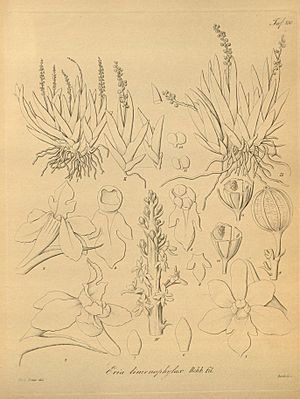Norfolk Island caterpillar orchid facts for kids
Quick facts for kids Norfolk Island caterpillar orchid |
|
|---|---|
 |
|
| Illustration from Reichenbach's book Xenia orchidacea | |
| Conservation status | |
| Scientific classification | |
| Genus: |
Phreatia
|
| Species: |
limenophylax
|
| Synonyms | |
|
|
The Phreatia limenophylax, also known as the Norfolk Island caterpillar orchid, is a special plant from the orchid family. It's an epiphyte, which means it grows on other plants, like trees, but doesn't take food from them. Imagine it like a plant that uses a tree as a comfy seat! This orchid has four to six thick, grooved leaves that spread out like a fan. It also grows many tiny white flowers on a thin stem. You can find this unique orchid on the Solomon Islands, Norfolk Island, and other islands in the southwest Pacific.
Contents
What Does the Norfolk Island Caterpillar Orchid Look Like?
The Norfolk Island caterpillar orchid is a plant that grows on trees. It has a short stem and thin roots. It usually has between four and six thick, dark green leaves. These leaves are about 20 to 60 millimeters (about 1 to 2.5 inches) long and 2 to 4 millimeters (about 0.1 to 0.2 inches) wide. They grow in a fan shape.
This orchid produces many small, greenish-white flowers. Each flower is only about 1 millimeter (about 0.04 inches) long and wide. These tiny flowers grow along a thin stem that is about 20 to 30 millimeters (about 0.8 to 1.2 inches) long. The flowers have small leaf-like parts called bracts. The sepals and petals, which are like the flower's outer and inner "leaves," are very tiny, about 0.5 millimeters (about 0.02 inches) long. The labellum, which is a special lip-like petal on an orchid, is also about 0.5 millimeters long. This orchid usually blooms between January and April.
How the Norfolk Island Caterpillar Orchid Got Its Name
The Norfolk Island caterpillar orchid was first officially described in 1833 by a scientist named Stephan Endlicher. He gave it the name Plexaure limenophylax. He wrote about it in his book called Prodromus Florae Norfolkicae. The very first plant specimen used for this description was collected by Ferdinand Bauer near Anson Bay on the western side of Norfolk Island.
Later, in 1873, another scientist named George Bentham changed the orchid's name to Phreatia limenophylax. The second part of its name, limenophylax, comes from Ancient Greek words. "Limeno-" means "harbour" or "refuge," and "phylax" means "guard." So, its name might mean something like "harbour guard" or "refuge guard."
Where the Norfolk Island Caterpillar Orchid Lives
The Norfolk Island caterpillar orchid typically grows on trees in rainforests. It can be found in several places across the Pacific. These include the Solomon Islands, Norfolk Island, Fiji, New Caledonia, Samoa, Vanuatu, and the Wallis and Futuna Islands. On Norfolk Island, there are only five known plants left. These rare orchids are all found in the Mount Pitt section of the Norfolk Island National Park.
Why the Norfolk Island Caterpillar Orchid Needs Our Help
This special orchid is in big trouble. It is classified as "critically endangered" by the Australian Government under a law called the Environment Protection and Biodiversity Conservation Act 1999. This means there are very few of these orchids left in the wild, and they are at a very high risk of disappearing forever. Protecting their rainforest homes is super important to help these unique plants survive.


